Chicago Electric 68316 User Manual

Owner’s Manual & Safety Instructions
Save This Manual Keep this manual for the safety warnings and precautions, assembly, operating, inspection, maintenance and cleaning procedures. Write the product’s serial number in the back of the manual near the assembly diagram (or month and year of purchase if product has no number). Keep this manual and the receipt in a safe and dry place for future reference.
ITEM 68316
|
Visit our website at: http://www.harborfreight.com |
|
Email our technical support at: tech@harborfreight.com |
REV 12b |
When unpacking, make sure that the product is intact and undamaged. If any parts are missing or broken, please call 1-800-444-3353 as soon as possible.
Copyright© 2010 by Harbor Freight Tools®. All rights reserved.
No portion of this manual or any artwork contained herein may be reproduced in any shape or form without the express written consent of Harbor Freight Tools.
Diagrams within this manual may not be drawn proportionally. Due to continuing improvements, actual product may differ slightly from the product described herein.
Tools required for assembly and service may not be included.
Read this material before using this product. Failure to do so can result in serious injury. SAVE THIS MANUAL.

SAFETY
SETUP
Table of Contents
Safety.......................................................... |
2 |
Maintenance............................................... |
16 |
Specifications.............................................. |
8 |
Parts List and Diagram............................... |
18 |
Setup........................................................... |
8 |
Warranty..................................................... |
20 |
Operation................................................... |
10 |
|
|
WARNING SYMBOLS AND DEFINITIONS
This is the safety alert symbol. It is used to alert you to potential personal injury hazards. Obey all safety messages that follow this symbol to avoid possible injury or death.
Indicates a hazardous situation which, if not avoided, will result in death or serious injury.
Indicates a hazardous situation which, if not avoided, could result in death or serious injury.
Indicates a hazardous situation which, if not avoided, could result in minor or moderate injury.
Addresses practices not related to personal injury.
IMPORTANT SAFETY INFORMATION
General Power Tool Safety Warnings
OPERATION
MAINTENANCE
Read all safety warnings and instructions.
Failure to follow the warnings and instructions may result in electric shock, fire and/or serious injury.
Save all warnings and instructions for future reference.
The term ″power tool″ in the warnings refers to your mains-operated (corded) power tool.
Work area safety
1. |
Keep work area clean and well lit. |
3. Keep children and bystanders |
|
Cluttered or dark areas invite accidents. |
away while operating a power tool. |
2. |
Do not operate power tools in explosive |
Distractions can cause you to lose control. |
|
atmospheres, such as in the presence of flammable liquids, gases or dust. Power tools create sparks which may ignite the dust or fumes.
Electrical safety
1.Power tool plugs must match the
outlet. Never modify the plug in any way. Do not use any adapter plugs with grounded power tools. Unmodified plugs and matching outlets will reduce risk of electric shock.
2.Avoid body contact with grounded surfaces such as pipes, radiators, ranges and refrigerators. There is an increased risk of electric shock if your body is grounded.
3.Do not expose power tools to rain or wet conditions. Water entering a power tool will increase the risk of electric shock.
4.Do not abuse the cord. Never use the cord for carrying, pulling or unplugging the power tool. Keep cord away from heat, oil, sharp edges or moving parts. Damaged or entangled cords increase the risk of electric shock.
Page 2 |
For technical questions, please call 1-800-444-3353. |
SKU 68316 |

Electrical safety (cont.)
5. When operating a power tool outdoors, use |
6. If operating a power tool in a damp location |
an extension cord suitable for outdoor use. |
is unavoidable, use a Ground Fault Circuit |
Use of a cord suitable for outdoor use |
Interrupter (GFCI) protected supply. |
reduces the risk of electric shock. |
Use of a GFCI reduces the risk of electric shock. |
Personal safety |
|
1.Stay alert, watch what you are doing and use common sense when operating a power tool. Do not use a power tool while you are tired or under the influence of drugs, alcohol or
medication. A moment of inattention while operating power tools may result in serious personal injury.
2.Use safety equipment. Always wear eye protection. Safety equipment such as dust mask, non-skid safety shoes, hard hat, or hearing protection used for appropriate conditions will reduce personal injuries.
3.Prevent unintentional starting. Ensure the switch is in the off-position before connecting to power source and/or battery pack, picking up or carrying the tool. Carrying power tools with your finger on the switch or energizing power tools that have the switch on invites accidents.
4.Remove any adjusting key or wrench before turning the power tool on.
A wrench or a key left attached to a rotating part of the power tool may result in personal injury.
5.Do not overreach. Keep proper footing and balance at all times. This enables better control of the power tool in unexpected situations.
6.Dress properly. Do not wear loose clothing or jewelry. Keep your hair, clothing and gloves away from moving parts. Loose clothes, jewelry or long hair can be caught in moving parts.
7.If devices are provided for the connection of dust extraction and collection facilities, ensure these are connected and properly used. Use of these devices can reduce dust related hazards.
8.Only use safety equipment that has been approved by an appropriate standards agency.
Unapproved safety equipment may not provide adequate protection. Eye protection must
be ANSI approved and breathing protection must be NIOSH approved for the specific hazards in the work area.
Power tool use and care
1.Do not force the power tool. Use the correct power tool for your application.
The correct power tool will do the job better and safer at the rate for which it was designed.
2.Do not use the power tool if the switch does not turn it on and off. Any power tool that cannot be controlled with the switch is dangerous and must be repaired.
3.Disconnect the plug from the power source and/or the battery pack from the power tool before making any adjustments, changing accessories, or storing power tools.
Such preventive safety measures reduce the risk of starting the power tool accidentally.
4.Store idle power tools out of the reach of children and do not allow persons unfamiliar with the power tool or these instructions
to operate the power tool. Power tools are dangerous in the hands of untrained users.
5.Maintain power tools. Check for misalignment or binding of moving parts, breakage of parts and any other condition that may affect the power tool’s operation. If damaged, have the power tool repaired before use. Many accidents are caused by poorly maintained power tools.
6.Keep cutting tools sharp and clean. Properly maintained cutting tools with sharp cutting edges are less likely to bind and are easier to control.
7.Use the power tool, accessories and blades etc. in accordance with these instructions, taking into account the working conditions and the work to be performed. Use of the power tool for operations different from those intended could result in a hazardous situation.
SAFETY
SETUP
OPERATION
MAINTENANCE
SKU 68316 |
For technical questions, please call 1-800-444-3353. |
Page 3 |

SAFETY
SETUP
OPERATION
MAINTENANCE
Service
Have your power tool serviced by a qualified repair person using only identical replacement parts. This will ensure that the safety of the power tool is maintained.
Circular Saw Safety Warnings
1. DANGER: Keep hands away from cutting area and the blades. Keep your second hand on auxiliary handle, or motor housing. If both hands
DANGER: Keep hands away from cutting area and the blades. Keep your second hand on auxiliary handle, or motor housing. If both hands
are holding the saw, they cannot be cut by the blades.
2.Do not reach underneath the workpiece.
The guard cannot protect you from the blades below the workpiece.
3.Adjust the cutting depth to the thickness of the workpiece. Less than a full tooth of the blades’ teeth should be visible below the workpiece.
4.Never hold piece being cut in your hands or across your leg. Secure the workpiece to a stable platform. It is important to support the work properly to minimize body exposure, blade binding, or loss of control.
5.Hold power tool by insulated gripping surfaces when performing an operation where the cutting tool may contact hidden wiring or its own cord. Contact with a ″live″ wire will also make exposed metal parts of the power tool ″live″ and shock the operator.
6.When ripping always use a rip fence or straight edge guide. This improves the accuracy of cut and reduces the chance of blade binding.
7.Always use blades with correct size and shape (diamond versus round) of arbor holes.
Blades that do not match the mounting hardware of the saw will run eccentrically, causing loss of control.
8.Never use damaged or incorrect blade washers or bolt. The blade washers and bolt were specially designed for your saw, for optimum performance and safety of operation.
9.Causes and Operator Prevention of Kickback:
•Kickback is a sudden reaction to a pinched, bound or misaligned saw blades, causing an uncontrolled saw to lift up and out of the workpiece toward the operator;
•When the blades are pinched or bound tightly by the kerf closing down, the blades stall and the motor reaction drives the unit rapidly back toward the operator;
•If the blades become twisted or misaligned in the cut, the teeth at the back edge of the blades can dig into the top surface of the wood causing the blades to climb out of the kerf and jump back toward the operator.
Kickback is the result of saw misuse and/or incorrect operating procedures or conditions and can be avoided by taking proper precautions as given below:
a.Maintain a firm grip with both hands on the saw and position your arms to resist kickback forces. Position your body to either side of the blades, but not in line with the blades.
Kickback could cause the saw to jump backwards, but kickback forces can be controlled by the operator, if proper precautions are taken.
b.When blades are binding, or when interrupting a cut for any reason, release the trigger
and hold the saw motionless in the material until the blades come to a complete stop. Never attempt to remove the saw from the work or pull the saw backward while the blades are in motion or kickback may occur.
Investigate and take corrective actions to eliminate the cause of blade binding.
c.When restarting a saw in the workpiece, center the saw blades in the kerf and check that saw teeth are not engaged into the material. If saw blades are binding, they may walk up or kickback from the workpiece as the saw is restarted.
d.Support large panels to minimize the risk of blade pinching and kickback. Large panels tend to sag under their own weight. Supports must
be placed under the panel on both sides, near the line of cut and near the edge of the panel.
e.Do not use dull or damaged blades.
Unsharpened or improperly set blades produce narrow kerf causing excessive friction, blade binding and kickback.
f.Blade depth and bevel adjusting locking levers must be tight and secure before making cut.
If blade adjustment shifts while cutting, it may cause binding and kickback.
g.Use extra caution when making a
″plunge cut″ into existing walls or other blind areas. The protruding blades may cut objects that can cause kickback.
Page 4 |
For technical questions, please call 1-800-444-3353. |
SKU 68316 |

Circular Saw Safety Warnings (cont.)
10.Check lower guard for proper closing before each use. Do not operate the saw if lower guard does not move freely and close instantly. Never clamp or tie the lower guard into the open position. If saw is accidentally dropped, lower guard may be bent. Raise the lower guard with the retracting handle and make sure it
moves freely and does not touch the blades or any other part, in all angles and depths of cut.
11.Check the operation of the lower guard spring. If the guard and the spring are not operating properly, they must be serviced before use.
Lower guard may operate sluggishly due to damaged parts, gummy deposits, or a build-up of debris.
12.Lower guard should be retracted manually only for special cuts such as ″plunge cuts″ and ″compound cuts.″ Raise lower guard by retracting handle and as soon as blades enter the material, the lower guard must be released. For all other sawing, the lower guard should operate automatically.
13.Always observe that the lower guard is covering the blades before placing saw down on bench or floor. Unprotected, coasting blades will cause the saw to walk backwards, cutting whatever
is in its path. Be aware of the time it takes for the blades to stop after switch is released.
14.DO NOT USE THIS SAW WITH THE SAW HELD UPSIDE DOWN IN A VISE.
The saw is not designed for such use and cannot be used safely in that position.
15.Do not use to cut logs, tree limbs, or uneven lumber.
16.Wet lumber, green (unseasoned) lumber, and pressure treated lumber all have
an increased potential for kickback and should only be cut with blades for cutting that lumber type. Wear a NIOSH-approved respirator and have appropriate ventilation whenever cutting pressure treated lumber.
17.Do not use blades made from high-speed steel, abrasive blades, metal-cutting blades or masonrycutting blades. The guards of this saw are not designed to protect against the failure of such blades.
18.Place the larger portion of the saw base on the larger, supported part of the workpiece.
This will help maintain balance and control while the cut is completed.
19.Closely observe position of saw’s housing during cut. Do not let housing bump
up against material being cut.
20.Blades must be rated to at least the maximum speed marked on the tool. Use only blades designed SPECIFICALLY for this saw.
21.Maintain labels and nameplates on the tool. These carry important safety information.
If unreadable or missing, contact Harbor Freight Tools for a replacement.
22.Avoid unintentional starting.
Prepare to begin work before turning on the tool.
23.Do not lay the tool down until it has come to a complete stop. Moving parts can grab the surface and pull the tool out of your control.
24.When using a handheld power tool, maintain a firm grip on the tool with both hands to resist starting torque.
25.Do not leave the tool unattended when it is plugged into an electrical outlet. Turn off the tool, and unplug it from its electrical outlet before leaving.
26.Use clamps (not included) or other practical ways to secure and support the workpiece to a stable platform. Holding the work by hand or against your body is unstable and may lead to loss of control.
27.This product is not a toy.
Keep it out of reach of children.
28.Verify that there are no utility lines or hardware in or near the workpiece. This is especially critical for plunge cuts.
29.Do not depress the spindle lock when starting or during operation.
SAFETY
SETUP
OPERATION
MAINTENANCE
SKU 68316 |
For technical questions, please call 1-800-444-3353. |
Page 5 |

SAFETY
SETUP
OPERATION
Circular Saw Safety Warnings (cont.)
30.WARNING: Handling the cord on this product will expose you to lead, a chemical known to the State of California to cause cancer, and birth defects or other reproductive harm. Wash hands after handling. (California Health & Safety Code § 25249.5, et seq.)
31.WARNING: Some dust created by power sanding, sawing, grinding, drilling, and other construction activities, contains chemicals known [to the State of California] to cause cancer, birth defects or other reproductive harm. Some examples of these chemicals are:
•Lead from lead-based paints
•Crystalline silica from bricks and cement or other masonry products
•Arsenic and chromium from
chemically treated lumber
Your risk from these exposures varies, depending on how often you do this type of work. To reduce your exposure to these chemicals: work in a well ventilated area, and work with approved safety equipment, such as those dust masks that are specially designed to filter out microscopic particles.
(California Health & Safety Code § 25249.5, et seq.)
32.People with pacemakers should consult their physician(s) before use. Electromagnetic fields in close proximity to heart pacemaker could cause pacemaker interference or pacemaker failure. In addition, people with pacemakers should:
•Avoid operating alone.
•Do not use with power switch locked on.
•Properly maintain and inspect to avoid
electrical shock.
• Any power cord must be properly grounded.
Ground Fault Circuit Interrupter (GFCI) should also be implemented – it prevents sustained electrical shock.
33.The warnings, precautions, and instructions discussed in this instruction manual cannot cover all possible conditions and situations that may occur. It must be understood by the operator that common sense and caution are factors which cannot be built into this product, but must be supplied by the operator.
Vibration Safety
This tool vibrates during use. Repeated or long-term exposure to vibration may cause temporary or permanent physical injury, particularly to the hands, arms and shoulders. To reduce the risk of vibration-related injury:
1.Anyone using vibrating tools regularly or for an extended period should first be examined by a doctor and then have regular medical checkups to ensure medical problems are not being caused or worsened from use. Pregnant women or people who have impaired blood circulation to the hand, past hand injuries, nervous system
disorders, diabetes, or Raynaud’s Disease should not use this tool. If you feel any medical or physical symptoms related to vibration (such as tingling, numbness, and white or blue fingers), seek medical advice as soon as possible.
2.Do not smoke during use. Nicotine reduces the blood supply to the hands and fingers, increasing the risk of vibration-related injury.
3.Use tools with the lowest vibration when there is a choice.
4.Include vibration-free periods each day of work.
5.Grip tool as lightly as possible (while still keeping safe control of it). Let the tool do the work.
6.To reduce vibration, maintain the tool as explained in this manual. If any abnormal vibration occurs, stop use immediately.
 SAVE THESE INSTRUCTIONS.
SAVE THESE INSTRUCTIONS.
MAINTENANCE
Page 6 |
For technical questions, please call 1-800-444-3353. |
SKU 68316 |
